Replacing the Flames: German anti-aircraft missile projects. Part II
The Wasserfall and Hs-117 Schmetterling projects of anti-aircraft guided missiles described in the first part of the article had one characteristic flaw. They were created, as they say, with a foundation for the future, and therefore their design was difficult enough to start production in wartime. Theoretically, in peaceful conditions it was possible to start the production of such anti-aircraft missiles, but in the second half of the Second World War, this could only be dreamed of. These troubles were extremely annoying to the Luftwaffe. The fact is that over time the German pilots, using a technique whose characteristics differed slightly from the enemy, could not respond to reports of raids with due speed. This will be especially serious in 45, when Allied bombers will reach their targets in just a couple of hours. The time interception problem, as it seemed, could only be solved with the help of special high-speed missiles. In principle, this thought was correct, but it was necessary to first create these rockets and organize their production.
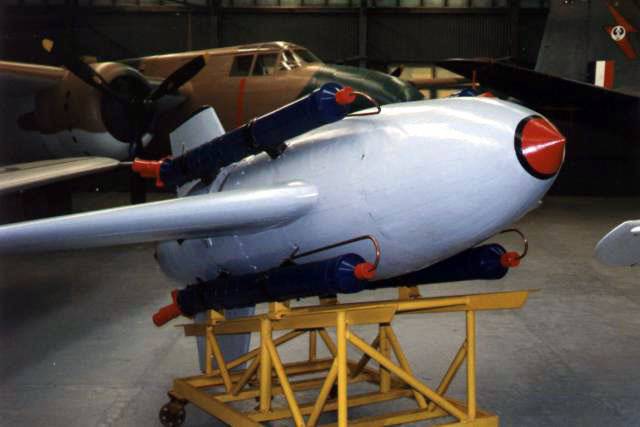
In 1943, on an emergency basis, the leadership of the German air force initiated the development of the Enzian missile. The development was entrusted to the company Messerschmitt, namely a small group of designers under the leadership of Dr. Witster, which shortly before it was transferred to the Messerschmitt AG. It is believed that this translation was decisive in the fate of the project "Entsian". To speed up the project, Witster was asked to use the maximum number of Messerschmitt projects. Given the purpose of Enzian, the works of A. Lippish on the project Me-163 Komet turned out to be very opportune. The fighter called “Comet” was supposed to fly at enormous speeds for that time, and Lippisch first prudently conducted a lot of tests in wind tunnels in order to determine the optimal hull lines, shape and profile of the wing. Naturally, Witster became interested in the Me-163 project. In the end, this was reflected in the appearance of the finished Entsiana.
The tailless tail of the mixed design was a midplane with a swept wing. At the rear of the fuselage were two keels, one on the upper side and the other on the bottom. The length of the fuselage relative to the "Comet" was reduced to 3,75 meters, and the wingspan of the Enzian rocket was 4 meters. The power elements of the fuselage and its skin were made by stamping steel alloys. Wings and keels to save, it was proposed to make wood with linen trim. Later, at the end of 44, an idea will appear to make the entire anti-aircraft missile frame wooden, and to use plastic for the skin. However, the war was already coming to an end, and this proposal was not really realized even in the drawings. To ensure the movement of the rocket in the air should have been some kind of two-stage power plant. For take-off from the launch guide, the Entsian had four solid-fuel Schmidding 109-553 accelerators with 40 kilograms of fuel each. Accelerator fuel burned out in four seconds, during which each of them created thrust of the order of 1700 kgf. Then the main engine Walter HWK 109-739 was turned on and the rocket could start the flight to the target.
The tactical qualities of the new anti-aircraft missile were to be ensured, first of all, by its combat unit. As part of the last there was almost 500 kilogram (!) Of ammotol. In the future, it was planned to equip the warhead with ready-made fragments. Having sacrificed several tens of kilograms of explosives, the designers could equip the rocket with several thousand destructive elements. It is not difficult to imagine what a miss could afford a missile with such a destructive potential or what damage it would have caused if it hit the bombers. The charge detonation was to be carried out by a contactless fuse. Initially, its creation was entrusted to several firms at once, but over time, taking into account the situation at the front, Witster began to promote the idea of a radio command fuse. Fortunately for the pilots of the anti-Hitler coalition, none of the types of fuses did not even reach the testing stage.
Of particular interest is the Enzian anti-aircraft missile launch complex. Fully following the principle of unification with existing technology, the design team of Dr. Witster chose the FlaK 88 XM anti-aircraft gun as the basis for the launcher. The only change in the design of the gun carriage was the fact that instead of a cannon a ten-meter launch guide was mounted on it. The guide had a collapsible design, which made it possible to assemble and disassemble the launcher in a relatively short time. Thus, it was possible to quickly enough make the transfer of anti-aircraft batteries. Naturally, if the project came to practical implementation.
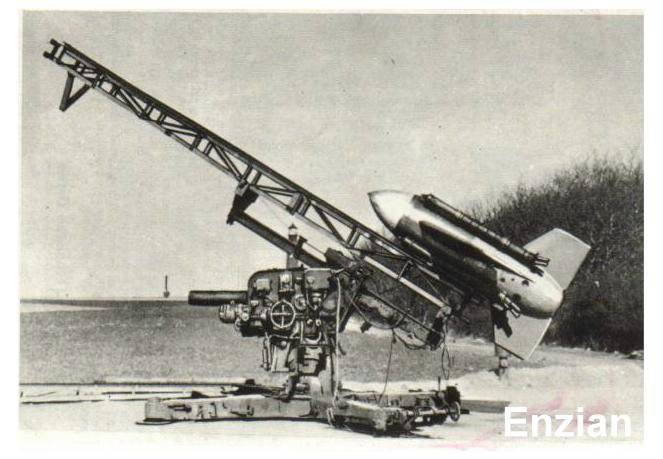
Enzian complex guidance system was quite complicated for that time. With the help of a radar station, the calculation of an anti-aircraft complex found a target and began to observe it with an optical device. With an estimated launch range of up to 25 kilometers, this was quite real, although inconvenient in the event of adverse weather conditions. The rocket tracking device was synchronized with the optical target tracking device. With his help, the rocket operator watched her flight. The rocket flight was corrected using the control panel, and the signal was transmitted to the missile defense system via radio. Thanks to the synchronization of the optical tracking devices for the target and the rocket, as well as due to the small distance between them, such a system made it possible to output the missile to the target with acceptable accuracy. Upon reaching the meeting point, the warhead was to be detonated using a proximity or radio command fuse. In addition, the operator had a special button to destroy the rocket in the event of a miss. The self-destruct fuse was made independent of combat.
During the development of the Enzian project, four missile versions were created:
- E-1. The original version. All the description above applies to it;
- E-2. Further upgrading of the E-1. Differs in the layout of components and assemblies, as well as a warhead weighing 320 kg;
- E-3. The development of E-2 with a large use of wooden parts;
- E-4. Deep modernization of the E-3 version with a full wooden frame, plastic lining and a Konrad VfK 613-A01 main engine.
Despite the seeming abundance of ideas from the designers, only the E-1 version was more or less worked out. That he happened to reach the stage of testing. In the second half of 44, missile test launches began. The first 22 launches were aimed at testing the power plant of the rocket and identifying problems of aerodynamic, constructive, etc. character The following 16 launches were “handed over” to the guidance system. About half of the 38 launches were unsuccessful. For rocket technology of the time, this was not a very bad indicator. But during the tests revealed very unpleasant facts. As it turned out, in a hurry, the designers under the guidance of Dr. Witster sometimes openly turned a blind eye to some problems. A number of calculations were made with errors, and some of them could rightfully be considered not only negligence, but also a real sabotage. As a result of all this, several vital parameters of the rocket were calculated incorrectly and there could be no question of any exact observance of the conditions of technical specifications. Enzian E-1 missile tests were carried out before March 1945. All this time, the designers tried to “plug” the identified “holes” in the project, although they did not achieve much success. In March, 45, the German leadership, apparently hoping for something else, froze the project. Why the project was not closed is unknown, but appropriate assumptions can be made. Before the capitulation of Nazi Germany, less than two months remained, and, of course, on this story project "Entsian" ended.
Documentation on the project went to several winning countries. A brief analysis of the drawings, and most importantly, the test reports showed that instead of a promising means of air defense, Enzian turned out to be an unsuccessful undertaking, which should not have appeared in peacetime, let alone about the war. The developments on the Entsian were not used by anyone.
Specifications of Enzian E-1:
Length - 3,75 m.
The wing span is 4 m.
Starting weight without accelerators - 1800 kg.
The mass of the warhead - 500 kg.
The maximum calculated launch range is 25 km.
The maximum estimated height of the lesion is 16 km.
Engine thrust is approx. 2000 kgf.
Thrust booster - approx. 6800 kgf.
Rheintochter
In November, 1942, the company Rheinmetall-Borsig received an order to develop a promising anti-aircraft guided missile. The main requirement, in addition to the height and range of defeat, concerned simplicity and low cost. For almost the entire 42 year, Americans and British were actively bombing objects in Germany. To protect them, they needed to do something efficient and inexpensive. The price requirement had a simple explanation. The fact is that even a small number of enemy bomber who reached the target could perform their combat mission and destroy any object. Obviously, a large number of missiles would cost a pretty penny. Therefore, anti-aircraft missile had to be as cheap as possible. It should be noted that the designers of “Rhinmetall” completely succeeded.
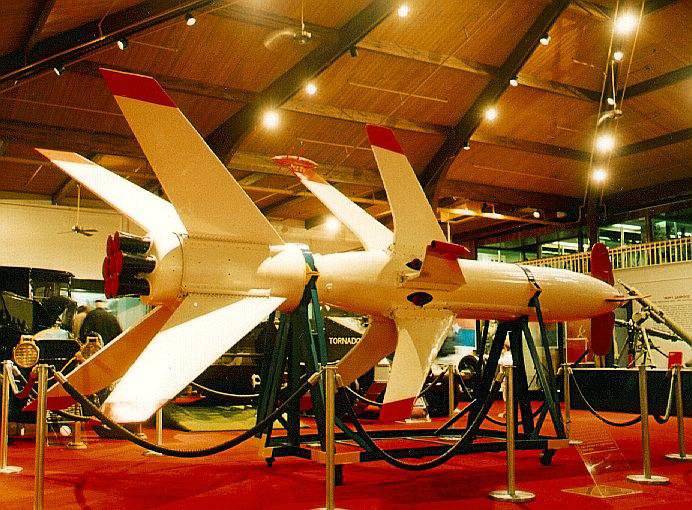
The designers of Rheinmetall-Borsig first of all analyzed the requirements and developed an approximate look of the future rocket. They concluded that the main "enemy" of an anti-aircraft missile is its size and weight. The dimensions, to some extent, worsen the aerodynamics of the rocket and, as a result, reduce the flight characteristics, and a lot of weight requires a more powerful and expensive engine. In addition, the large weight of the rocket imposes the corresponding requirements for the start of the entire ammunition. In most German ZUR projects, the start was provided by solid fuel boosters. However, the designers of "Rheinmetall" it did not suit, again, for weight reasons. Therefore, in the Rheintochter project (literally “The Daughter of the Rhine” - the character of R. Wagner’s operas from the Nibelung Ring cycle), for the first time in the field of anti-aircraft missiles, a solution was applied, which later became one of the standard SAM systems. It was a two-step system.
The initial acceleration of the R-1 missile was assigned to a detachable first stage. It was a simple steel cylinder with a wall thickness of the order of 12 mm. At the ends of the cylinder were placed two hemispherical caps. The top cover was made solid, and seven holes were cut in the bottom. Nozzles were attached to these holes. It is interesting that the main central nozzle was made interchangeable: in the complete set, several nozzles of various configuration were attached to each rocket. As conceived by the designers, depending on the weather conditions, the calculation of the anti-aircraft battery could establish exactly the nozzle that gives the best flight characteristics in the existing conditions. At the factory, 19 powder checkers with a total weight of 240 a kilogram were placed inside the plant. The fuel supply of the first stage was enough for 0,6 seconds of operation of the solid-fuel engine. Further, ignition of pyrobolts took place and the second stage was disconnected with the subsequent start of its engine. In order that the first stage did not “hang” on a rocket with an ordinary accelerator, it was equipped with four arrow-shaped stabilizers.
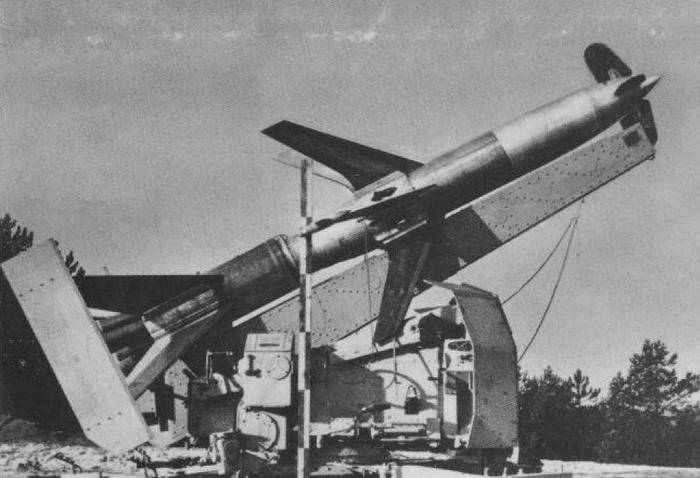
The design of the second stage of the R-1 rocket was more complicated. In the middle part of it they placed their own main engine. It was a steel cylinder (wall thickness 3 mm) diameter 510 millimeters. The second stage engine was equipped with another kind of gunpowder, so the kilogram charge in 220 was enough for ten seconds of work. Unlike the first stage, the second one had only six nozzles - placing the engine in the middle of the stage did not allow making the central nozzle. Six nozzles around the circumference were mounted on the outer surface of the rocket with a slight collapse outward. The warhead with 22,5 kg of explosive placed in the rear of the second stage. A very original decision, among other things, improved the balancing of the stage and the rocket as a whole. In the nose, in turn, were installed control equipment, electric generator, acoustic fuze and steering cars. On the outer surface of the second stage of the R-1 rocket, in addition to the six nozzles, there were six arrow-shaped stabilizers and four aerodynamic rudders. The latter were placed on the very nose of the stage, so that the Rheintochter R-1 also became the world's first anti-aircraft missile, made according to the “duck” scheme.
It was planned to carry out missile guidance with the help of commands from the ground. For this, the Rheinland system was used. It consisted of two radar target detection and missiles, a remote control and a number of related equipment. In case of problems with radar detection of a rocket, two second-stage stabilizers had pyrotechnic tracers at the ends. The combat operation of the air defense missile system with the R-1 missiles should have happened as follows: the calculation of the anti-aircraft battery receives information about the location of the target. Further calculation independently makes detection of the purpose and starts the rocket. By pressing the "start" button, the first-stage powder checkers are ignited, and the rocket comes off the guide. After 0,6-0,7 seconds after launch, the first stage, after having dispersed the rocket to 300 m / s, is separated. At this stage, you can begin targeting. The automatic equipment of the ground part of the air defense system monitored the movements of the target and the rocket. The task of the operator was to hold the light spot on the screen (missile mark) at the cross in the center (target mark). Commands from the control panel in encrypted form were transmitted to the rocket. Undermining its warhead occurred automatically with an acoustic fuse. An interesting fact is that in the first moments after the launch of the rocket, the radar antenna for tracking the rocket had a broad radiation pattern. After removing the missile at a sufficient distance, the tracking station automatically narrowed the “beam”. If necessary, optical observation equipment could be included in the Rhineland guidance system. When this movement of the optical system sight, synchronized with the antenna radar target detection.
The first test run of the Rheintochter R-1 was carried out in August 1943 at the test site near the city of Liepaja. In the course of the first few starts, the engines and the control system were tested. Already in the first months of testing, before the start of 44, some of the drawbacks of the construction used were revealed. So, within the line of sight, the rocket was aimed at the target quite successfully. But the rocket was removed, gained altitude and accelerated. All this led to the fact that after a certain range limit, only a very experienced operator could manage the rocket flight normally. By the end of 44, over 80 had been made full-fledged launches and less than ten of them were unsuccessful. The R-1 missile was almost recognized as a successful and necessary German air defense, but ... The engine of the second stage was too small to get to a height of more than 8 km. But most of the Allied bombers have flown precisely at these altitudes. The German leadership had to close the R-1 project and initiate the beginning of a major modernization of this rocket in order to bring the characteristics to an acceptable level.
This happened in May of 44, when it became clear that all attempts to improve R-1 were futile. New modification of missiles received the name Rheintochter R-3. Two modernization projects were launched at once. The first of these, the R-3P, envisaged the use of a new solid-fuel engine in the second stage, and the second stage was equipped with a liquid-propellant rocket engine in the R-3F project. Work on the modernization of the solid engine gave almost no results. The then German rocket powders for the most part could not combine in themselves a great deal of thrust and low fuel consumption, which affected the height and range of the missile’s flight. Therefore, the focus was on the variant R-3F.
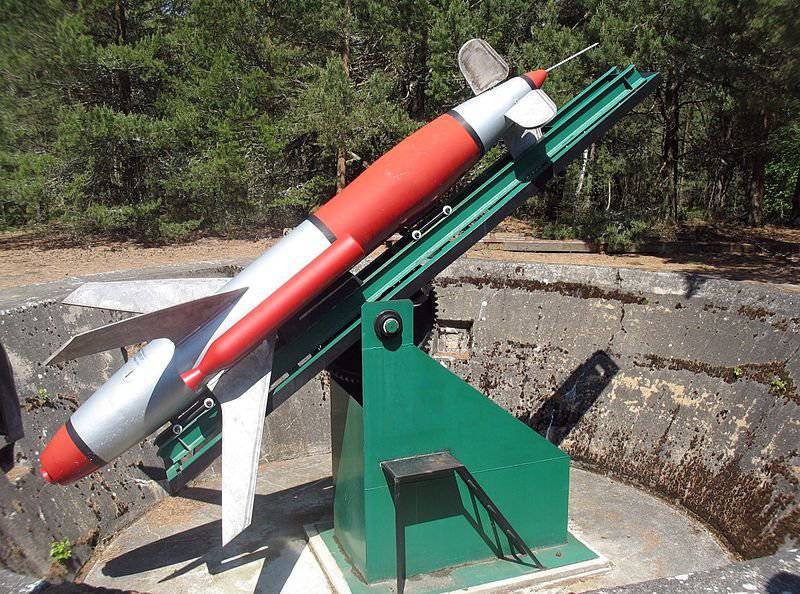
The basis for the second stage of the R-3F was taken the corresponding part of the R-1 rocket. The use of a liquid engine required to significantly rework its design. So, the only now nozzle was placed in the bottom of the stage, and the warhead was transferred to its middle part. Also had to slightly change its structure, because now the CU was located between the tanks. Two variants were considered as a fuel pair: “Tonka-250” plus nitric acid and “Visol” plus nitric acid. In both cases, the engine could, during the first 15-16 seconds, produce thrust to 2150 kgf, and after that it decreased to 1800 kgf. The stock of liquid fuel in the R-3F tanks was enough for 50 seconds of engine operation. Moreover, to improve the combat performance, the option of installing two solid-fuel boosters to the second stage or even completely abandoning the first stage was seriously considered. As a result, the height of reach managed to reach 12 kilometers, and the slant range - to 25 km.
By the beginning of the 1945 of the year, about a dozen or so missiles of the R-3F variant were manufactured, which were sent to the Peenemünde test range. The start of the test of the rocket was scheduled for mid-February, but the situation on all fronts forced the German leadership to abandon the Rheintochter project in favor of more pressing things. Work on it, as well as on all other projects, after the end of the war in Europe became the trophies of the allies. The two-stage scheme of the R-1 rocket interested designers in many countries, as a result of which over the next years several types of anti-aircraft missiles with a similar structure were created.
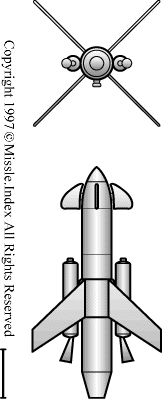
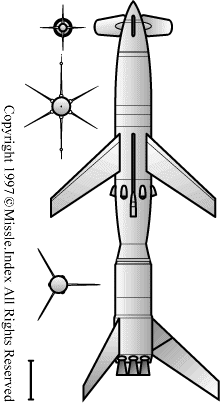
Specifications missile R-1:
Length - 10,3 m.
Scope of stabilizers - 2,75 m.
Case diameter - 510 mm.
Starting weight - 1750 kg.
The total weight of the warhead is up to 50 kg.
The maximum launch range is 12 km.
The maximum height of the lesion is 8 km.
Technical characteristics of the R-3F rocket (only the second stage):
Length - 4,75 m.
Wingspan - about 2,75 m (no exact data).
Case diameter - 510 mm.
Starting weight - 976 kg.
The mass of the warhead - up to 40 kg.
The maximum launch range is 35 km.
The maximum height of the lesion is 12 km.
Feuerlilie
Not all German developments in the field of anti-aircraft guided missiles managed to get out of the design stage or go through full-fledged tests. A typical representative of the last "class" is the program Feuerlilie ("Fire Lily"), according to which two rockets were created at once. In some ways, the Feuerlilie rocket was designed to compete with the Rheintochter, a simple, cheap and effective anti-aircraft defense. The development of this rocket also commissioned Rheinmetall-Borsig.
By design, the first version of the Feuerlilie rocket, the F-25, simultaneously resembled a rocket and an airplane. At the rear of the fuselage there were two half-wings-stabilizer with steering surfaces on the rear edge. The ends of the keels were placed at their ends. The combat part of the rocket on the project had a weight of the order of 10-15 kilogram. Various types of control systems were considered, but in the end the designers stopped on autopilot, into which the flight program corresponding to the situation was “loaded” before the launch.
In May, the first F-1943 prototypes were delivered to the Loeb test site in May. There were about 25 launches and their results were clearly insufficient. The rocket accelerated only to 30 m / s and could not rise to a height greater than 210-2800 meters. Of course, for protection against the American “Flying Fortresses”, this was clearly not enough. The monstrously ineffective guidance system completed the bleak picture. Until the autumn of 3000, the F-43 project did not live.
Rheinmetall, however, did not stop his work on the Feuerlilie program. A new project was launched with the designation F-55. In fact, it was three almost independent projects. Basically, they went back to F-25, but had a number of differences from both the previous “Lily” and from each other, namely:
- Prototype # 1. Rocket with a solid-fuel engine (4 checkers) and a launch weight of 472 kg. On tests, she reached speed in 400 m / s and reached the height of 7600 meters. The guidance system for this rocket was supposed to be a radio command;
- Prototype # 2. The development of the previous version is characterized by large size and weight. The first trial launch was unsuccessful - because of several shortcomings in the design, an experienced rocket exploded at the start. Further prototypes were able to demonstrate flight characteristics, which, however, did not change the fate of the project;
- Prototype # 3. Attempt to reanimate the LRE in the program Feuerlilie. In size rocket №3 is similar to the second prototype, but has a different powerplant. The start was to be made with the help of solid fuel boosters. In the autumn of 44, the prototype prototype # XXUMX was transported to Peenemünde, but its tests were not started.
At the end of December 1944, the military leadership of Nazi Germany, taking into account the progress of the Feuerlilie project, the failures and the results achieved, decided to close it. At that time, the designers of other companies offered much more promising projects and because of this, it was decided not to spend forces and funds on a deliberately weak project, which was the “Fire Lily”.
Specifications missile F-25:
Length - 2,08 m.
Case diameter - 0,25 m.
Scope of the stabilizer - 1,15 m.
Starting weight - 120 kg.
Maximum speed - approx. 750 km / h.
The maximum launch range is 5 km.
The maximum height of the lesion is 3 km.
Specifications rocket F-55 (prototype number 2):
Length - 4,8 m.
Case diameter - 0,55 m.
Scope of the stabilizer - 2,5 m.
Starting weight - 665 kg.
The maximum speed is 1700 km / h.
The maximum launch range is 9,7 km.
The maximum height of the lesion is up to 8 km.
On the materials of the sites:
http://pvo.guns.ru/
http://www.ausairpower.net/
http://www.luft46.com/
http://missile.index.ne.jp/
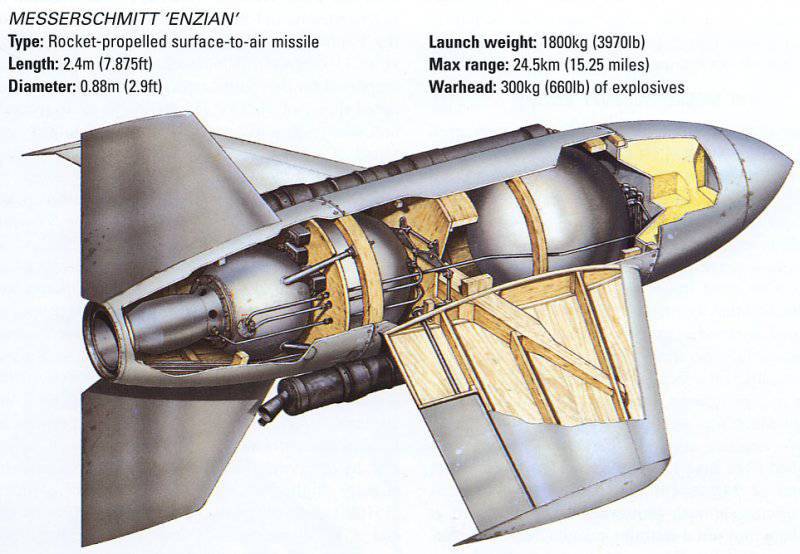
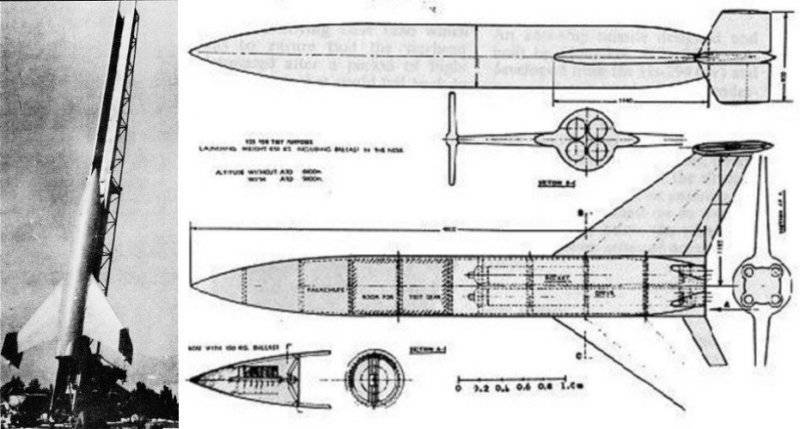

Information